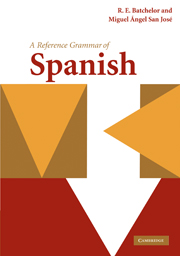Book contents
- Frontmatter
- Contents
- Preface/Prólogo
- Acknowledgments/Agradecimientos
- Abbreviations/Abreviaturas
- Introduction to the Spanish language/Introducción a la lengua española
- Part I
- 1 Register/Registro
- 2 Alphabet, spelling, pronunciation/Alfabeto, ortografía, pronunciación
- 3 Stress and accent marks/Acento tónico y acento ortográfico
- 4 Punctuation, upper case, lower case/Puntuación, mayúsculas, minúsculas
- 5 Apocopation/Apócope
- 6 Agreement/Concordancia
- Part II
- Part III
- Part IV
- Part V
- Part VI
- Part VII
- Part VIII
- Part IX
- Part X
- Appendix I Verb tables/ Tablas de verbos
- Appendix II Glossary/Glosario
- Bibliography/Bibliografía
- General index/Índice general
- Subjunctive index/Índice del subjuntivo
6 - Agreement/Concordancia
from Part I
Published online by Cambridge University Press: 05 June 2012
- Frontmatter
- Contents
- Preface/Prólogo
- Acknowledgments/Agradecimientos
- Abbreviations/Abreviaturas
- Introduction to the Spanish language/Introducción a la lengua española
- Part I
- 1 Register/Registro
- 2 Alphabet, spelling, pronunciation/Alfabeto, ortografía, pronunciación
- 3 Stress and accent marks/Acento tónico y acento ortográfico
- 4 Punctuation, upper case, lower case/Puntuación, mayúsculas, minúsculas
- 5 Apocopation/Apócope
- 6 Agreement/Concordancia
- Part II
- Part III
- Part IV
- Part V
- Part VI
- Part VII
- Part VIII
- Part IX
- Part X
- Appendix I Verb tables/ Tablas de verbos
- Appendix II Glossary/Glosario
- Bibliography/Bibliografía
- General index/Índice general
- Subjunctive index/Índice del subjuntivo
Summary
Below is a piece of Spanish illustrating, in a limited way, how agreement between nouns and verbs, and adjectives and nouns, functions. Relevant words/parts of words are shown in bold.
Casi la mitad de los alumnos salieron temprano en el autobús; la mayoría llevaba chubasquero y paraguas, porque, a pesar de que un poco antes una infinidad de estrellas titilaban (sparkled) en el cielo, el amanecer auguraba tormentas, y todos temían que la excursión terminara pasada por agua. El grupo de alumnos iba afectado, temiendo pasar el día bajo la lluvia o el granizo, hasta que uno de ellos logró animar el viaje sacando una vieja armónica y comenzando a tocar alegres melodías, consiguió que los compañeros relajaran el ánimo, y a poco, se elevaron las canciones por encima del ruido del desvencijado (worn out) motor.
(Treatment of agreement appears throughout this book. For example, gender and number are analyzed in Part II; verbs and agreement of endings according to the subject receive attention in Part III; tenses according to the coincidence of main and subordinate clauses are also dealt with in Part III; and agreement of adjectives with nouns are examined in Parts VI and VIII. Nevertheless, at the risk of a slight overlap between the present chapter and other chapters in the book, it seems helpful to deal in a general way with the concept of agreement between various grammatical accidences since it is a fundamental feature of all Romance languages, and Spanish is no exception.)
- Type
- Chapter
- Information
- A Reference Grammar of Spanish , pp. 42 - 48Publisher: Cambridge University PressPrint publication year: 2010



